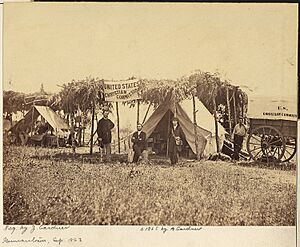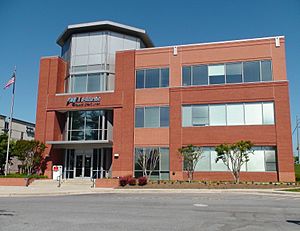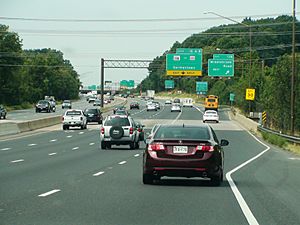Germantown, Maryland facts for kids
Quick facts for kids
Germantown, Maryland
|
|
|---|---|
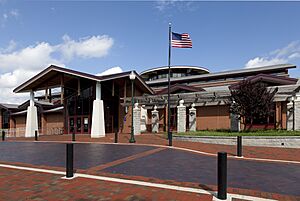
Germantown Library
|
|
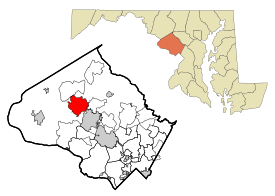
Location of Germantown in Montgomery County and Maryland
|
|
| Country | United States |
| State | Maryland |
| County | Montgomery |
| Area | |
| • Total | 17.12 sq mi (44.35 km2) |
| • Land | 17.03 sq mi (44.12 km2) |
| • Water | 0.09 sq mi (0.23 km2) |
| Elevation | 489 ft (149 m) |
| Population
(2020)
|
|
| • Total | 91,249 |
| • Density | 5,357.19/sq mi (2,068.40/km2) |
| Time zone | UTC−5 (Eastern (EST)) |
| • Summer (DST) | UTC−4 (EDT) |
| ZIP code |
20874, 20875 (PO box only), 20876
|
| Area code(s) | 301, 240 |
| FIPS code | 24-32025 |
| GNIS feature ID | 2389836 |
Germantown is a busy community in Montgomery County, Maryland. It is a "census-designated place," which means it's a specific area counted by the government. With over 91,000 people in 2020, it's the third-largest community in Maryland.
Germantown is about 28 miles (45 km) from Washington, D.C.. This makes it an important part of the larger Washington area. The town was started in the early 1800s by people from Europe. However, most of its growth happened much later, in the mid-1900s.
The original plan for Germantown included a downtown area and six smaller villages. These villages were Gunners Lake, Kingsview, Churchill, Middlebrook, Clopper's Mill, and Neelsville. The Churchill Town Sector is often seen as the main center of Germantown. Here you can find the Upcounty Regional Services Center, the Germantown Public Library, and the Black Rock Arts Center. There are also many shops and restaurants.
Getting around Germantown is easy. There are three exits to I-270 nearby. The Maryland Area Regional Commuter (MARC) train station is also within walking distance. Plus, the Germantown Transit Center offers shuttle service to the Washington Metro's Red Line at Shady Grove station.
Germantown has specific ZIP codes for mail delivery: 20874 and 20876. The ZIP code 20875 is for post office boxes only. It is the only "Germantown, Maryland" officially recognized by the United States Postal Service.
Contents
Discovering Germantown's Past
How Germantown Began (1830–1865)
In the 1830s and 1840s, the main business area of Germantown was around Liberty Mill Road and Clopper Road. Several German immigrants opened businesses there. Because of this, the town became known as "German Town." However, most people living there at the time were from England or Scotland.
Germantown During the Civil War
The American Civil War (1861-1865) caused many disagreements among Germantown residents. Some people were against slavery and had family fighting for the Union Army. Others owned slaves or had family fighting for the Confederate Army. This led to people avoiding each other. They might switch churches or travel far to different stores.
In 1861, over 20,000 Union soldiers camped near Germantown. They sometimes visited the town's stores. In 1862 and 1863, Union soldiers marched through Germantown on their way to big battles like Antietam and Gettysburg. In 1864, Confederate soldiers also passed through. Farmers in the area often lost their animals to both armies.
Growing Up: Germantown's Expansion (1865–1950)
Germantown did not have a public school until after the Civil War. Before that, children learned at home. In 1868, a one-room schoolhouse was built. It served children from Germantown and nearby Darnestown. A larger school was built in 1883, and an even newer one in 1910. This 1910 school had four rooms and taught two grade levels in each. After eighth grade, students took a train to Rockville for more schooling.
The Bowman Brothers Mill, a wooden building, burned down in 1914. But four years later, a new company called Liberty Milling Company bought it. Augustus Selby managed the new Liberty Mill, which opened in 1918. This mill brought electricity to Germantown, making it the first area in northern Montgomery County to have power.
A famous baseball player named Walter Perry Johnson bought a farm in Germantown in 1935. He was a pitcher for the Washington Senators. He lived there with his family until he passed away in 1946. Today, Seneca Valley High School stands on the land where his dairy farm used to be. A road near the school is named after him.
Liberty Mill became the second-largest mill in Maryland. It had eight silos and supplied flour to the United States Army during World War II. They also made cornmeal and animal feed. After the war, the mill fell apart and was later destroyed by a fire in 1972. The silos were removed in 1986 to make space for the MARC train station parking lot.
Modern Germantown: Development and Growth (1950–Present)
In 1958, the U.S. Atomic Energy Commission moved its offices to Germantown. This was because it was far enough from Washington, D.C., to be safe from a possible attack. Today, this facility is an office complex for the U.S. Department of Energy.
Farmers in Germantown began selling their land to developers in the 1950s and 60s. This was especially true after I-270 was built, dividing some farms. In 1964, Fairchild-Hiller Corporation bought land and built an industrial park.
The Germantown Master Plan was created in 1967. This plan aimed to guide the growth of the 17-square-mile (44 km2) area. It suggested a busy downtown area surrounded by less crowded developments. The plan was updated in 1974 to include a downtown and six separate villages. Each village would have schools, shops, and public buildings. The plan also included building a third campus for Montgomery College. The completion of a sewer line in 1974 also helped Germantown grow quickly.
During the 1970s, Wernher von Braun, a famous rocket scientist, worked in Germantown. He was a vice president for Fairchild Industries. The A-10 Thunderbolt airplane and parts of the Space Shuttle were designed in their Germantown offices.
The Germantown Campus of Montgomery College opened in 1978. It started with two buildings, 24 employees, and 1,200 students. By 2003, it had grown to five thousand students and four buildings. There's a cool steel water tower on campus that looks like the Earth from space!
Germantown Today: Economy and Community (1980–Present)

Since the 1980s, Germantown has grown very fast. Many new homes and businesses have been built. In 1986, Germantown was the fastest-growing ZIP code in the Washington area. Its population grew by over 300% in the 1980s!
In 2000, the Upcounty Regional Services Center opened. It housed the Germantown Public Library until the library moved to a new building in 2007. This center was renamed the Sidney Kramer Upcounty Regional Services Center in 2013.
The Maryland SoccerPlex opened in Germantown in 2000. This huge sports complex has 19 grass fields, 3 artificial fields, and a soccer stadium with 5,200 seats. It also has indoor courts, miniature golf, a splash park, and more! The Washington Spirit women's soccer team used to play here. The Germantown Swim Center is also part of the SoccerPlex.
In 2003, one of Germantown's mobile home parks, the Cider Barrel Mobile Home Park, closed. However, the unique Barrel building itself was saved. Plans to reopen the Barrel as a bakery were delayed by the COVID-19 pandemic.
In 2014, Holy Cross Health opened a large hospital on the Montgomery College campus. This was the first hospital in the U.S. built on a community college campus. It helps students get hands-on experience in medical fields.
In 2023, Germantown was named the most ethnically diverse city in the United States by WalletHub!
Germantown's Location and Weather
Germantown covers about 10.9 square miles (28.0 km2). Most of this area is land.
Climate and Temperatures
Germantown has a humid subtropical climate. This means it has hot, humid summers and cool winters. It gets a good amount of rain all year. Because it's in the Piedmont region, its temperatures are a bit cooler than cities closer to the coast.
- Summers: Hot and humid with frequent afternoon thunderstorms. July is the warmest month, with an average temperature of 86 °F (30.0 °C).
- Winters: Cool and can change a lot. It gets some snow and longer, lighter rain showers. January is the coldest month, with an average temperature of 29 °F (−1.7 °C).
- Rainfall: Germantown gets about 40.36 in (103 cm) of rain each year.
Who Lives in Germantown?
| Historical population | |||
|---|---|---|---|
| Census | Pop. | %± | |
| 1980 | 9,721 | — | |
| 1990 | 41,145 | 323.3% | |
| 2000 | 55,419 | 34.7% | |
| 2010 | 86,395 | 55.9% | |
| 2020 | 91,249 | 5.6% | |
| Source: 2010–2020 |
|||
In 2013, Germantown had about 90,676 people. By 2020, the population grew to 91,249.
- Diversity: In 2010, the population was made up of many different groups:
* 36.3% White * 21.8% African American * 19.7% Asian * 18.4% Hispanic or Latino * Other groups made up the rest.
- Households: In 2010, there were over 30,500 households. About 41% of them had children under 18 living there.
- Age: The average age in Germantown was 31 years old. About 29% of the population was under 18.
| Population by Race in Germantown, Maryland (2010) | ||
| Race | Population | % of Total |
|---|---|---|
| Total | 86,395 | 100 |
| Caucasian | 31,102 | 36.3 |
| African American | 18,813 | 21.8 |
| Asian | 17,001 | 19.7 |
| Hispanic | 15,879 | 18.4 |
| Other | 258 | 0.3 |
| Two or more races | 2,847 | 3.3 |
| American Indian | 172 | 0.2 |
| Source: | ||
Germantown's Economy
Germantown has become a hub for many high-tech companies. This is because of its growth and location along the I-270 highway. Several companies have their main offices here, including:
- Qiagen North America
- Earth Network Systems Inc.
- Digital Receiver Technology Inc.
- Mid-Atlantic Federal Credit Union
- Hughes Network Systems
Many other companies also have offices in Germantown, such as Xerox, General Electric Aviation, and Viasat.
Learning in Germantown: Schools and College
All public schools in Germantown are part of the Montgomery County Public Schools (MCPS) system.
Elementary Schools
Germantown has many elementary schools, including:
- Cedar Grove Elementary School
- Clopper Mill Elementary School
- Fox Chapel Elementary School
- Germantown Elementary School
- Great Seneca Creek Elementary School
- Captain James E. Daly Jr. Elementary School
- Lake Seneca Elementary School
- Ronald McNair Elementary School
- Sally K. Ride Elementary School
- Spark Matsunaga Elementary School
- S. Christa McAuliffe Elementary School
- Waters Landing Elementary School
- William B. Gibbs Jr. Elementary School
Middle Schools
The four middle schools in Germantown are:
- Kingsview Middle School
- Dr. Martin Luther King Jr. Middle School
- Neelsville Middle School
- Roberto W. Clemente Middle School
High Schools
Students from these middle schools go on to three different high schools:
- Northwest High School (from Kingsview)
- Clarksburg High School (from Neelsville)
- Seneca Valley High School (from Dr. Martin Luther King Jr. and Roberto W. Clemente)
The Longview School, which helps students with special education needs, is also in Germantown.
Higher Education: Montgomery College
Montgomery College is the largest higher education school in Montgomery County. Its biggest campus is located in Germantown, near the downtown area.
Culture and Fun in Germantown

Music and Arts
The BlackRock Center for the Arts is a great place for music and art in downtown Germantown. They host the annual Germantown Oktoberfest, a fall festival with different types of music, including traditional German folk, rock, and pop. The Harmony Express Men's Chorus is a men's singing group based in Germantown.
The famous rock band Clutch is from Germantown. The band members went to Seneca Valley High School together and formed the band in 1991.
Sports and Recreation
The Maryland SoccerPlex is a huge sports complex in Germantown. It has fields for soccer and lacrosse, and a stadium. Many tournaments are held here. The Montgomery County Road Runners Club also hosts a half marathon that starts and finishes at the SoccerPlex. The Germantown Swim Center, a place for swimming events, is also part of the SoccerPlex.
Local History
The Germantown Historical Society (GHS) works to teach people about local history and protect historic places. Their office and future museum are in the old Germantown Bank building. The GHS offers talks about history and has traveling exhibits. They also host a large flea market from April to November.
News and Information
Germantown used to have a news website called the Germantown Pulse. It covered local sports, schools, and events. However, the website stopped updating in 2019.
Supporting Veterans
Veterans in Germantown are supported by the Vietnam Veterans Memorial, American Legion Post 295. This group helps Cub Scout Pack 436 and other youth programs. They also support American Legion Boys State and American Legion Baseball.
Getting Around Germantown
Germantown is divided by I-270, which is one of Maryland's busiest highways. This highway connects Germantown to Frederick to the north and Bethesda and the Capital Beltway to the south. There are three exits for Germantown on I-270.
Germantown also has a train station for the MARC train's Brunswick Line. The station building looks like the original one from 1891.
The Montgomery County bus system, Ride On, has a major hub in Germantown called the Germantown Transit Center. About 20 bus routes use this center, making it one of the busiest in the county.
As of 2017, there are plans for a light rail system called the Corridor Cities Transitway. If built, it would connect the Washington Metro Red Line at Shady Grove station to Germantown and then continue north to Clarksburg.
Famous People from Germantown
Many interesting people have connections to Germantown:
- Steve Armas, a soccer player and coach.
- Members of the rock band Clutch went to Seneca Valley High School here.
- Danny Heater, a high school basketball player who set a scoring record, lived in Germantown.
- Members of the rock band Hootie and the Blowfish also attended Seneca Valley High School.
- Walter Perry Johnson, a famous baseball pitcher, lived on a farm in Germantown from 1935 until his death in 1946.
- Bobby Liebling from the doom metal band Pentagram.
- Jake Rozhansky, a professional soccer player.
- Isaiah Swann, a professional basketball player.
- Frank Warren, who started the PostSecret project.
- Harvey D. Williams, an African-American U.S. Army major general, lived here.
See also
In Spanish: Germantown (Maryland) para niños




